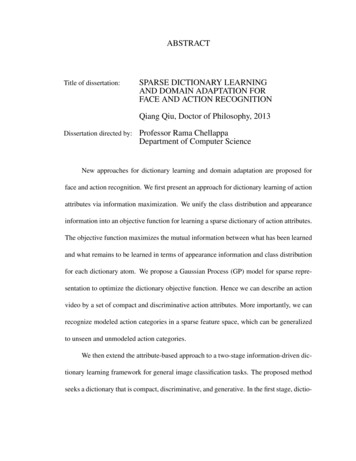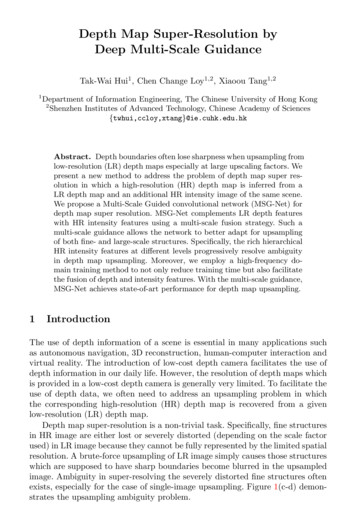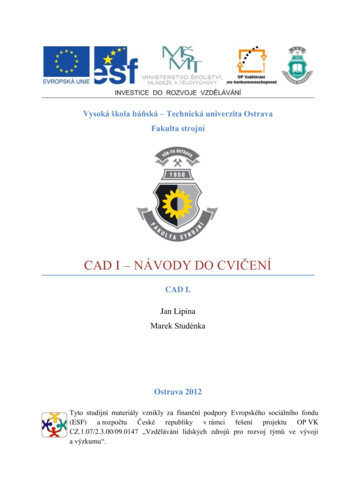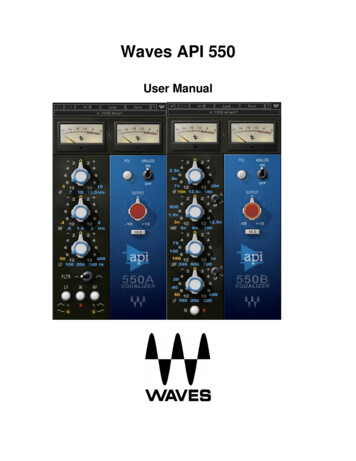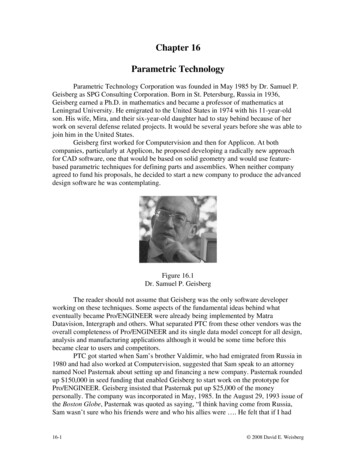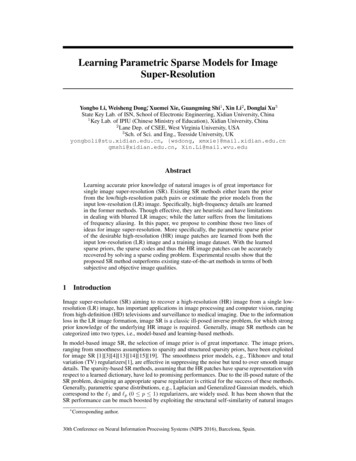
Transcription
Learning Parametric Sparse Models for ImageSuper-ResolutionYongbo Li, Weisheng Dong , Xuemei Xie, Guangming Shi1 , Xin Li2 , Donglai Xu3State Key Lab. of ISN, School of Electronic Engineering, Xidian University, China1Key Lab. of IPIU (Chinese Ministry of Education), Xidian University, China2Lane Dep. of CSEE, West Virginia University, USA3Sch. of Sci. and Eng., Teesside University, UKyongboli@stu.xidian.edu.cn, {wsdong, xmxie}@mail.xidian.edu.cngmshi@xidian.edu.cn, Xin.Li@mail.wvu.eduAbstractLearning accurate prior knowledge of natural images is of great importance forsingle image super-resolution (SR). Existing SR methods either learn the priorfrom the low/high-resolution patch pairs or estimate the prior models from theinput low-resolution (LR) image. Specifically, high-frequency details are learnedin the former methods. Though effective, they are heuristic and have limitationsin dealing with blurred LR images; while the latter suffers from the limitationsof frequency aliasing. In this paper, we propose to combine those two lines ofideas for image super-resolution. More specifically, the parametric sparse priorof the desirable high-resolution (HR) image patches are learned from both theinput low-resolution (LR) image and a training image dataset. With the learnedsparse priors, the sparse codes and thus the HR image patches can be accuratelyrecovered by solving a sparse coding problem. Experimental results show that theproposed SR method outperforms existing state-of-the-art methods in terms of bothsubjective and objective image qualities.1IntroductionImage super-resolution (SR) aiming to recover a high-resolution (HR) image from a single lowresolution (LR) image, has important applications in image processing and computer vision, rangingfrom high-definition (HD) televisions and surveillance to medical imaging. Due to the informationloss in the LR image formation, image SR is a classic ill-posed inverse problem, for which strongprior knowledge of the underlying HR image is required. Generally, image SR methods can becategorized into two types, i.e., model-based and learning-based methods.In model-based image SR, the selection of image prior is of great importance. The image priors,ranging from smoothness assumptions to sparsity and structured sparsity priors, have been exploitedfor image SR [1][3][4][13][14][15][19]. The smoothness prior models, e.g., Tikhonov and totalvariation (TV) regularizers[1], are effective in suppressing the noise but tend to over smooth imagedetails. The sparsity-based SR methods, assuming that the HR patches have sparse representation withrespect to a learned dictionary, have led to promising performances. Due to the ill-posed nature of theSR problem, designing an appropriate sparse regularizer is critical for the success of these methods.Generally, parametric sparse distributions, e.g., Laplacian and Generalized Gaussian models, whichcorrespond to the 1 and p (0 p 1) regularizers, are widely used. It has been shown that theSR performance can be much boosted by exploiting the structural self-similarity of natural images Corresponding author.30th Conference on Neural Information Processing Systems (NIPS 2016), Barcelona, Spain.
[3][4][15]. Though promising SR performance can be achieved by the sparsity-based methods, itis rather challenging to recover high-quality HR images for a large scaling factors, as there is nosufficient information for accurate estimation of the sparse models from the input LR image.Instead of adopting a specifical prior model, learning-based SR methods learn the priors directlyfrom a large set of LR and HR image patch pairs [2][5][6][8][18]. Specifically, mapping functionsbetween the LR and the high-frequency details of the HR patches are learned. Popular learning-basedSR methods include the sparse coding approaches[2] and the more efficient anchored neighborhoodregression methods (i.e., ANR and A )[5][6]. More recently, inspired by the great success of thedeep neural network (DNN)[16] for image recognition, the DNN based SR methods have also beenproposed[8], where the DNN models is used to learn the mapping functions between the LR andthe high-frequency details of the HR patches. Despite the state-of-the-art performances achieved,these patch-based methods [6][8] have limitations in dealing with the blurred LR images (as shownin Sec. 5). Instead of learning high-frequency details, in [12] Li et al. proposed to learn parametricsparse distributions (i.e., non-zero mean Laplacian distributions) of the sparse codes from retrievedHR images that are similar to the LR image. State-of-the-art SR results have been achieved for thelandmark LR images, for which similar HR images can be retrieved from a large image set. However,it has limitations for general LR images (i.e., it reduces to be the conventional sparsity-based SRmethod), for which correlated HR images cannot be found in the image database.In this paper, we propose a novel image SR approach combining the ideas of sparsity-based andlearning-based approaches for SR. The sparse prior, i.e., the parametric sparse distributions (e.g.,Laplace distribution) are learned from general HR image patches. Specifically, a set of mappingfunctions between the LR image patches and the sparse codes of the HR patches are learned. Inaddition to the learned sparse prior, the learned sparse distributions are also combined with thoseestimated from the input LR image. Experimental results show that the proposed method performsmuch better than the current state-of-the-art SR approaches.2Related worksIn model-based SR, it is often assumed that the desirable HR image/patches have sparse expansionswith respect to a certain dictionary. For a given LR image y Hx n, where H RM N specifiesthe degradation model, x RN and n RM denote the original image and additive Gaussian noise,respectively. Sparsity-based SR image reconstruction can be formulated as [3][4]X(x, α) argmin y Hx 22 η{ Ri x Dαi 22 λψ(α)},(1)x,αi where Ri Rdenotes the matrix extracting image patch of size n n at position i from x,D Rn K denotes the dictionary that is an off-the-shelf basis or learned from an training dataset,and ψ(·) denotes the sparsity regularizer. As recovering x from y is an ill-posed inverse problem,the selection of ψ(·) is critical for the SR performance. Common selection of ψ(·) is the p -norm(0 p 1) regularizer, where zero-mean sparse distributions of the sparse coefficients are assumed.In [12], nonzero-mean Laplacian distributions are used, leading to the following sparsity-based SRmethod,X(x, α) argmin y Hx 22 η{ Ri x Dαi 22 Λi (αi βi ) 1 },(2)n Nx,αi 2 2σ 2diag( θi,j n ),where Λ θi and βi denote the standard derivation and expectation of αi , respectively.It has been shown in [3] that by estimating {βi , θi } from the nonlocal similar image patches ofthe input image, promising SR performance can be achieved. However, for large scaling factors,it is rather challenging to accurately estimate {βi , θi } from the input LR image, due to the lackof sufficient information. To overcome this limitations, Li et al., propose to learn the parametricdistributions from retrieved similar HR images [12] via block matching, and obtain state-of-the-artSR performance for landmark images. However, for general LR images, for which similar HR imagescannot be found, the sparse prior (βi , θi ) cannot be learned.Learning-based SR methods resolve the SR problem by learning mapping functions between LR andHR image patches [2][6][8]. Popular methods include the sparse coding methods [2], where LR/HRdictionary pair is jointly learned from a training set. The sparse codes of the LR patches with respect2
to the LR dictionary are inferred via sparse coding and then used to reconstruct the HR patches withthe HR dictionary. To reduce the computational complexity, anchored neighborhood points (ANR)and its advanced version (i.e., A ) methods [6] have been proposed. These methods first divided thepatch spaces into many clusters, then LR/HR dictionary pairs are learned for each cluster. Mappingfunctions between the LR/HR patches are learned for each cluster via ridge regression. Recently,deep neural network (DNN) model has also been developed to learn the mapping functions betweenthe LR and HR patches [8]. The advantages of the DNN model is that the entire SR pipeline isjointly optimized via end-to-end learning, leading to state-of-the-art SR performance. Despite theexcellent performances, these learning-based methods focusing on learning the mapping functionsbetween LR and HR patches have limitations in recovering a HR image from a blurry LR imagegenerated by first applying a low-pass filtering followed by downsampling (as shown in Sec. 4). Inthis paper, we propose a novel image SR method by taking advantages of both the sparse-based andthe example-based SR approaches. Specifically, mapping functions between the LR patches andthe sparse codes of the desirable HR patches are learned. Hence, sparse prior can be learned fromboth the training patches and the input LR image. With the learned sparse prior, state-of-the-art SRperformance can be achieved.3Learning Parametric Sparse ModelsIn this section, we first propose a novel method to learn the sparse codes of the desirable HR patchesand then present the method to estimate the parametric distributions from both the predicted sparsecodes and those of the LR images.3.1Learning the sparse codes from LR/HR patch pairsFor a given LR image patch yi Rm , we aim to learn the expectation of the sparse code αi of thedesirable HR patch xi with respect to dictionary D. Without the loss of generality, we define thelearning function asα̃i f (zi ; W, b) g(W zi b),(3)K mwhere zi denotes the feature vector extracted from the LR patch yi , W Ris the weightingmatrix and b RK is the bias, and g(·) denotes an activation function. Now, the remaining taskis to learn the parameters of the learning function of Eq. (3). To learn the parameters, we firstconstruct a large set of LR feature vectors and HR image patch pairs {(zi , xi )}, i 1, 2, · · · , N .For a given dictionary, the sparse codes αi of xi can be obtained by a sparse coding algorithm. Then,the parameters W {W, b} can be learned by minimizing the following objective function(W, b) argminW,bNX αi f (zi ; W, b) 22 .(4)i 1The above optimization problem can be iteratively solved by using a stochastic gradient descentapproach.Considering the highly complexity of the mapping function between the LR feature vectors and thedesirable sparse codes, we propose to learn a set of mapping functions for each possible local imagestructures. Specifically, the K-means clustering algorithm is used to cluster the LR/HR patches intoK clusters. Then, a mapping function is learned for each cluster. After clustering, the LR/HR patchesin each cluster generally contain similar image structures, and linear mapping function would besufficient to characterize the correlations between the LR feature vectors and the sparse codes ofthe desirable HR patches. Therefore, for each cluster Sk , the mapping function can be learned viaminimizingX(Wk , bk ) argmin αi (Wk zi bk ) 22 .(5)Wk ,bk i SkFor simplicity, the bias term bk in the above equation can be absorbed into Wk by rewriting Wk andzi as Wk [Wk , bk ] and zi [zi ; 1] , respectively. Then, the parameters Wk can be easily solvedvia a least-square method.As the HR patches in each cluster generally have similar image structures, a compact dictionaryshould be sufficient to represent the various HR patches. Hence, instead of learning an overcompletedictionary for all HR patches, an orthogonal basis is learned for each cluster Sk . Specifically, a PCA3
Algorithm 1 Sparse codes learning algorithmInitialization:(a) Construct a set of LR and HR image pairs {y, x} and recover the HR images {x̂} with aconventional SR method;(b) Extract feature patches zi , the LR and HR patches yi and xi from {x̂, y, x}, respectively;(c) Clustering {zi , yi , xi } into K clusters using K-means algorithm.Outer loop: Iteration on k 1, 2, · · · , K(a) Calculate the PCA basis Dk for each cluster using the HR patches belong to the k-th cluster;(b) Computer the sparse codes as αi Sλ (D ki xi ) for each xi , i Sk ;(c) Learn the parameters W of the mapping function via solving Eq. (5).End forOutput: {Dk , Wk }.basis, denoted as Dk Rn n is learned for each Sk , k 1, 2, · · · , K. Then, the sparse codes αi canbe easily obtained αi Sλ (D ki xi ), where Dki denotes the PCA basis of the ki -th cluster. Regardingthe feature vectors zi , we extract feature vectors from an initially recovered HR image, which can beobtained with a conventional sparsity-based method. Similar to [5][6], the first- and second-ordergradients are extracted from the initially recovered HR image as the features. However, other moreeffective features can also be used. The sparse distribution learning algorithm is summarized inAlgorithm 1.3.2Parametric sparse models estimationAfter learning linearized mapping functions, denoted as α̃i , the estimates of αi can be estimated fromLR patch via Eq. (3). Based on the observation that natural images contain abundant self-repeatingstructures, a collection of similar patches can often be found for an exemplar patch. Then, the meanof αi can be estimated as a weighted average of the sparse codes of the similar patches. As theoriginal image is unknown, an initial estimate of the desirable HR image, denoted as x̂ is obtainedusing a conventional SR method, e.g., solving Eq. (2). Then, the search of similar patches can beconducted based on x̂. Let x̂i denote the patch extracted from x̂ at position i and x̂i,l denote thepatches similar to x̂i that are within the first L-th closest matches, l 1, 2, · · · , L. Denoted by zi,lthe corresponding features vectors extracted from x̂. Therefore, the mean of βi can be estimated byβ̃i LXwi,l α̃i,l ,(6)l 1where wi,l parameter.1cexp( x̂i,l x̂i /h), c is the normalization constant, and h is the predefinedAdditionally, we can also estimate the mean of space codes αi directly from the intermediate estimateof target HR image. For each initially recovered HR patch x̂i , the sparse codes can be obtainedvia a sparse coding algorithm. As the patch space has been clustered into K sub-spaces and acompact PCA basis is computed for each cluster, the sparse code of x̂i can be easily computed asα̂i,j Sλ (D ki x̂i,j ), where Sλ (·) is the soft-thresholding function with threshold λ, ki denote thecluster that x̂i falls into. The sparse codes of the set of similar patches x̂i,l can also be computed.Then, the expectation of βi can be estimated asβ̂i LXwi,j α̂i,l .(7)l 1Then, an improved estimation of βi can be obtained by combining the above two estimates, i.e.,βi β̃i (1 )β̂i .4(8)
where ωdiag(δj ) RK K . Similar to [12], δj is set according to the energy ratio of β̃i (j) andβ̂i (j) asrj2, rj β̃i (j)/β̂i (j).(9)δj 2rj 1/rj2And ω is a predefined constant. After estimating βi , the variance of the sparse codes are estimated asLθi2 1X(α̂i,j βi )2 .L j 1(10)The learned parametric Laplacian distributions with {βi , θi } for image patches xi are then used withthe MAP estimator for image SR in the next section.4Image Super-Resolution with learned Parametric Sparsity ModelsWith the learned parametric sparse distributions {(βi , θi )}, image SR problem can be formulated as(x̂, Âi ) argmin y xH 22 ηXxi ,Ai{ R̃i x Dki Ai 2F λiLX Λi (αi,l βi ) 1 },(11)l 1where R̃i x [Ri,1 x, Ri,2 x, · · · , Ri,L x] Rn L denotes the matrix formed by the similar patches,1).Ai [αi,1 , · · · , αi,L ], Dki denotes the selected PCA basis of the ki -th cluster, and Λi diag( θi,jIn Eq. (11), the group of similar patches is assumed to follow the same estimated parametricdistribution {βi , θi }. Eq. (11) can be approximately solved via alternative optimization. For fixedxi , the sets of sparse codes Ai can be solved by minimizingÂi argmin R̃i x Dki Ai 2F λAiLX Λi (αi,l βi ) 1(12)l 1As the orthogonal PCA basis is used, the above equation can be solved in closed-form solution, i.e.,α̂i,l Sτi (D ki Ri,l x βi ) βi ,where τi λ/θi . With estimated Âi , the whole image can be estimated by solvingXx̂ argmin y xH 22 η R̃i x Dki Ai 2F ,x(13)(14)iwhich is a quadratic optimization problem and admits a closed-form solution, asX X x̂ (H H ηR̃i R̃i ) 1 (H y ηR̃i Dki Âi ),i(15)iPLPL where R̃i R̃i l 1 R l Rl and R̃i Dki Âi l 1 Rl Dki α̂i,l . As the matrix to be inverted in Eq.(15) is very large, the conjugate gradient algorithm is used to compute Eq. (15). The proposed imageSR algorithm is summarized in Algorithm 2. In Algorithm 2, we iteratively extract the featurepatches from x̂(t) and learn β̃i from the training set, leading to further improvements in predictingthe sparse codes with the learned mapping functions.5Experimental resultsIn this section, we verify the performance of the proposed SR method. For fair comparisons, weuse the relative small training set of images used in [2][6]. The training images are used to simulatethe LR images, which are recovered by a sparsity-based method (e.g., the NCSR method [3]). Total100, 000 features and HR patches pairs are extracted from the reconstructed HR images and theoriginal HR images. Patches of size 7 7 are extracted from the feature images and HR images.Similar to [5][6], the PCA technique is used to reduce the dimensions of the feature vectors. Thetraining patches are clustered into 1000 clusters. The other major parameters of the proposed SR5
Algorithm 2 Image SR with Learned Sparse RepresentationInitialization:(a) Initialize x̂(0) with a conventional SR method;(b) Set parameters η and λ;Outer loop: Iteration over t 0, 1, · · · , T(a) Extract feature vectors zi from x̂(t) and cluster the patches into clusters;(b) Learn β̃i for each local patch using Eq. (6);(c) Update the estimate of βi using Eq. (8) and estimate θi with Eq. (10);(d) Inner loop (solve Eq.(11)): iteration over j 1, 2, · · · , J;(j 1)(I) Compute Aiby solving Eq.(13);(II) Update the whole image x̂(j 1) via Eq. (15);(III) Set x(t 1) x(j 1) if j J.End forOutput: x(t 1) .method are set as: L 12, T 8, and J 10. The proposed SR method is compared with severalcurrent state-of-the-art image SR methods, i.e., the sparse coding based SR method (denoted asSCSR)[2], the SR method based on sparse regression and natural image prior (denoted as KK) [7],the A method [6], the recent SRCNN method [8], and the NCSR method [3]. Note that the NCSR isthe current sparsity-based SR method. Three images sets, i.e., Set5[9], Set14[10] and BSD100[11],which consists of 5, 14 and 100 images respectively, are used as the test images.In this paper, we consider two types of degradation when generating the LR images, i.e., the bicubicimage resizing function implemented with imresize in matlab and Gaussian blurring followed bydownsampling with a scaling factor, both of which are commonly used in the literature of image SR.5.1Image SR for LR images generated with bicubic interpolation functionIn [2][6][7][8], the LR images are generated with the bicubic interpolation function (i.e., imresizefunction in Matlab), i.e., y B(x) n, where B(·) denotes the bicubic downsampling function. Todeal with this type of degradation, we implement the degradation matrix H as an operator that resizesa HR image using bicubic function with scaling factors of 1s and implement H as an operator thatupscales a LR image using bicubic function with scaling factor s, where s 2, 3, 4. The averagePSNR and SSIM results of the reconstructed HR images are reported in Table 1. It can be seen thatthe SRCNN method performs better than the A and the SCSR methods. It is surprising to see thatthe NCSR method, which only exploits the internal similar samples performs comparable with theSRCNN method. By exploiting both the external image patches and the internal similar patches, theproposed method outperforms the NCSR. The average PSNR gain over SRCNN can be up to 0.64dB. Parts of some reconstructed HR images by the test methods are shown in Fig. 1, from whichwe can see that the proposed method reproduces the most visually pleasant HR images than othercompeting methods. Please refer to the supplementary file for more visual comparison results.5.2Image SR for LR images generated with Gaussian blur followed by downsamplingAnother commonly used degradation process is to first apply a Gaussian kernel followed by downsampling. In this experimental setting, the 7 7 Gaussian kernel of standard deviation of 1.6 is used,followed by downsampling with scaling factor s 2, 3, 4. For these SCSR, KK, A and SRCNNmethods, which cannot deal with the Gaussian blur kernel, the iterative back-projection [17] methodis applied to the reconstructed HR images by those methods as a post processing to remove theblur. The average PSNR and SSIM results on the three test image sets are reported in Table 2. Itcan be seen that the performance of the example-based methods, i.e., SCSR[2], KK[7], A [6] andSRCNN[8] methods are much worse than the NCSR [3] method. Compared with the NCSR method,the average PSNR gain of the proposed method can be up to 0.46 dB, showing the effectiveness ofthe proposed sparse codes learning method. Parts of the reconstructed HR images are shown in Fig. 26
Table 1: Average PSNR and SSIM results of the test methods (LR images generated with bicubicresizing function)ImagesUpscalingSCSR[2]KK[7]A [6]SRCNN[8]NCSR[3]Proposed 0.9551Se5 0.914933.390.9173 4 32.610.9072Set14 0.823929.590.8264 4 31.420.8879BSD100 0.787228.560.7899 0.7187(a) Original(b) Bicubic(c) SCSR / 26.01dB(d) KK / 26.49dB(e) A / 26.55dB(f) SRCNN / 26.71dB(g) NCSR / 27.11dB(h) Proposed / 27.35dBFigure 1: SR results on image ’86000’ of BSD100 of scaling factor 3 (LR image generated withbicubic interpolation function).and Fig. 3. Obviously, the proposed method can recover sharper edges and finer details than othercompeting methods.6ConclusionIn this paper, we propose a novel approach for learning parametric sparse models for image superresolution. Specifically, mapping functions between the LR patch and the sparse codes of the desirableHR patches are learned from a training set. Then, parametric sparse distributions are estimated fromthe learned sparse codes and those estimated from the input LR image. With the learned sparsemodels, the sparse codes and thus the HR image patches can be accurately recovered by solving asparse coding problem. Experimental results show that the proposed SR method outperforms existingstate-of-the-art methods in terms of both subjective and objective image qualities.AcknowledgmentsThis work was supported in part by the Natural Science Foundation (NSF) of China under Grants(No.No. 61622210, 61471281, 61632019, 61472301, and 61390512), in part by the Specialized ResearchFund for the Doctoral Program of Higher Education (No. 20130203130001).7
Table 2: Average PSNR and SSIM results of the test methods of scaling factor 3 (LR images generatedwith Gaussian kernel followed by downsampling)SCSR[2] KK[7] A [6] SRCNN[8] NCSR[3] 8536 .63Set140.76190.7640 8.60BSD1000.73380.7342 0.73310.73380.78410.7887(a) Original(b) Bicubic(c) SCSR / 29.85dB(d) KK / 29.94dB(e) A / 29.48dB(f) SRCNN / 29.88dB(g) NCSR / 32.97dB(h) Proposed / 33.84dBFigure 2: SR results on ’Monarch’ from Set14 of scaling factor 3 (LR images generated with Gaussianblur followed downsampling).(a) Original(b) Bicubic(c) SCSR / 32.22dB(d) KK / 32.12dB(e) A / 30.81dB(f) SRCNN / 32.16dB(g) NCSR / 34.59dB(h) Proposed / 35.15dBFigure 3: SR results on ’Pepper’ from Set14 of scaling factor 3 (LR images generated with Gaussianblur followed downsampling).8
References[1] A. Marquina and S. J. Osher. Image super-resolution by TV-regularization and bregman iteration. Journal ofScientific Computing, 37(3):367–382, 2008.[2] J. Yang, J. Wright, T. S. Huang, and Y. Ma. Image super-resolution via sparse representation. IEEEtransactions on image processing, 19(11):2861–2873, 2010.[3] W. Dong, L. Zhang, G. Shi, and X. Li. Nonlocally centralized sparse representation for image restoration.IEEE Transactions on Image Processing, 22(4):1620–1630, 2013.[4] W. Dong, G. Shi, Y. Ma, and X. Li. Image restoration via simultaneous sparse coding: Where structuredsparsity meets gaussian scale mixture. International Journal of Computer Vision, 114(2-3):217–232, 2015.[5] R. Timofte, V. De Smet, and L. Van Gool. Anchored neighborhood regression for fast example-basedsuper-resolution. In Proceedings of the IEEE International Conference on Computer Vision, pages 1920–1927,2013.[6] R. Timofte, V. De Smet, and L. Van Gool. A : Adjusted anchored neighborhood regression for fastsuper-resolution. In Asian Conference on Computer Vision, pages 111–126. Springer, 2014.[7] K. I. Kim and Y. Kwon. Single-image super-resolution using sparse regression and natural image prior. IEEETransactions on Pattern Analysis and Machine Intelligence, 32(6):1127–1133, 2010.[8] C. Dong, C. C. Loy, K. He, and X. Tang. Image super-resolution using deep convolutional networks. IEEEtransactions on pattern analysis and machine intelligence, 38(2):295–307, 2016.[9] M. Bevilacqua, A. Roumy, C. Guillemot, and M. L. AlberiMorel. Low-complexity single-image superresolution based on nonnegative neighbor embedding. 2012.[10] R. Zeyde, M. Elad, and M. Protter. On single image scale-up using sparse-representations. In Internationalconference on curves and surfaces, pages 711–730. Springer, 2010.[11] D. Martin, C. Fowlkes, D. Tal, and J. Malik. A database of human segmented natural images and itsapplication to evaluating segmentation algorithms and measuring ecological statistics. In Computer Vision, 2001.ICCV 2001. Proceedings. Eighth IEEE International Conference on, volume 2, pages 416–423. IEEE, 2001.[12] Y. Li, W. Dong, G. Shi, and X. Xie. Learning parametric distributions for image super-resolution: Wherepatch matching meets sparse coding. In Proceedings of the IEEE International Conference on Computer Vision,pages 450–458, 2015.[13] W. Dong, L. Zhang, G. Shi, and X. Wu. Image deblurring and super-resolution by adaptive sparse domainselection and adaptive regularization. IEEE Transactions on Image Processing, 20(7):1838–1857, 2011.[14] W. Dong, L. Zhang, and G. Shi. Centralized sparse representation for image restoration. In 2011 International Conference on Computer Vision, pages 1259–1266. IEEE, 2011.[15] G. Yu, G. Sapiro, and S. Mallat. Solving inverse problems with piecewise linear estimators: From gaussianmixture models to structured sparsity. IEEE Transactions on Image Processing, 21(5):2481–2499, 2012.[16] A. Krizhevsky, I. Sutskever, and G. E. Hinton. Imagenet classification with deep convolutional neuralnetworks. In Advances in neural information processing systems, pages 1097–1105, 2012.[17] M. Irani and S. Peleg. Motion analysis for image enhancement: Resolution, occlusion, and transparency.Journal of Visual Communication and Image Representation, 4(4):324–335, 1993.[18] D. Dai, R. Timofte, and L. Van Gool. Jointly optimized regressors for image super-resolution. In ComputerGraphics Forum, volume 34, pages 95–104. Wiley Online Library, 2015.[19] K. Egiazarian and V. Katkovnik. Single image super-resolution via BM3D sparse coding. In SignalProcessing Conference (EUSIPCO), 2015 23rd European, pages 2849–2853. IEEE, 2015.9
patch spaces into many clusters, then LR/HR dictionary pairs are learned for each cluster. Mapping functions between the LR/HR patches are learned for each cluster via ridge regression. Recently, deep neural network (DNN) model has also been developed to learn the mapping func
